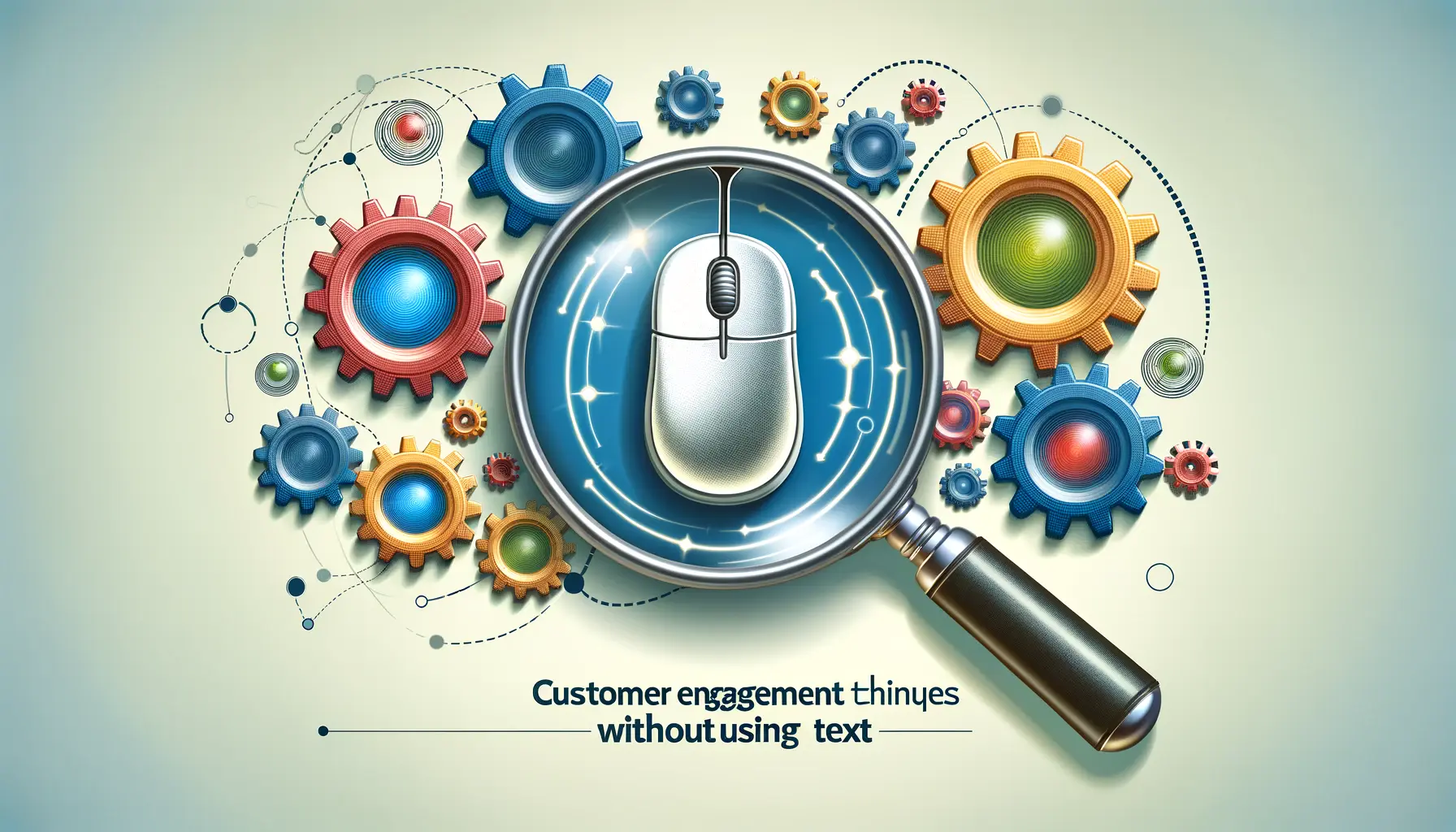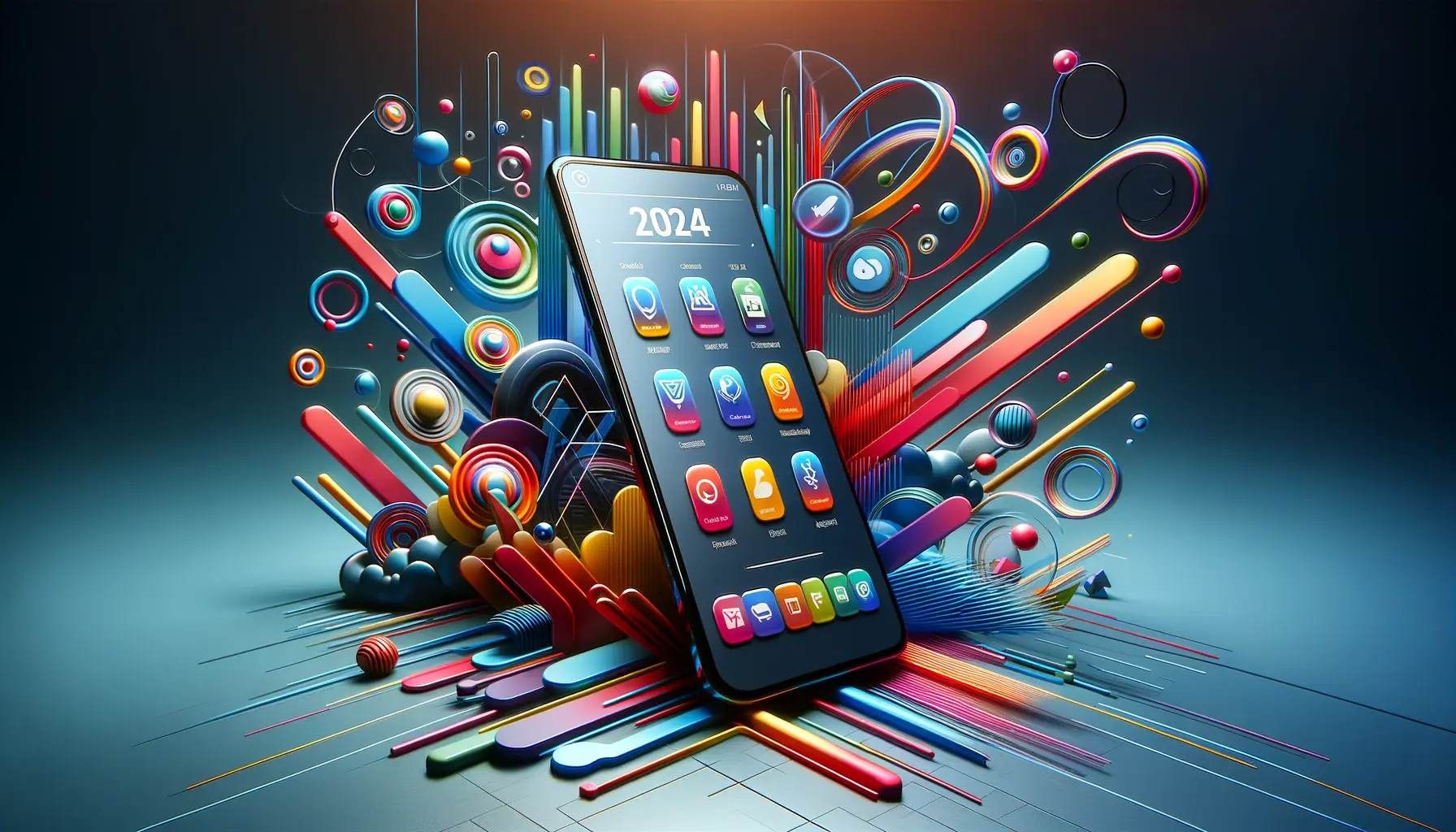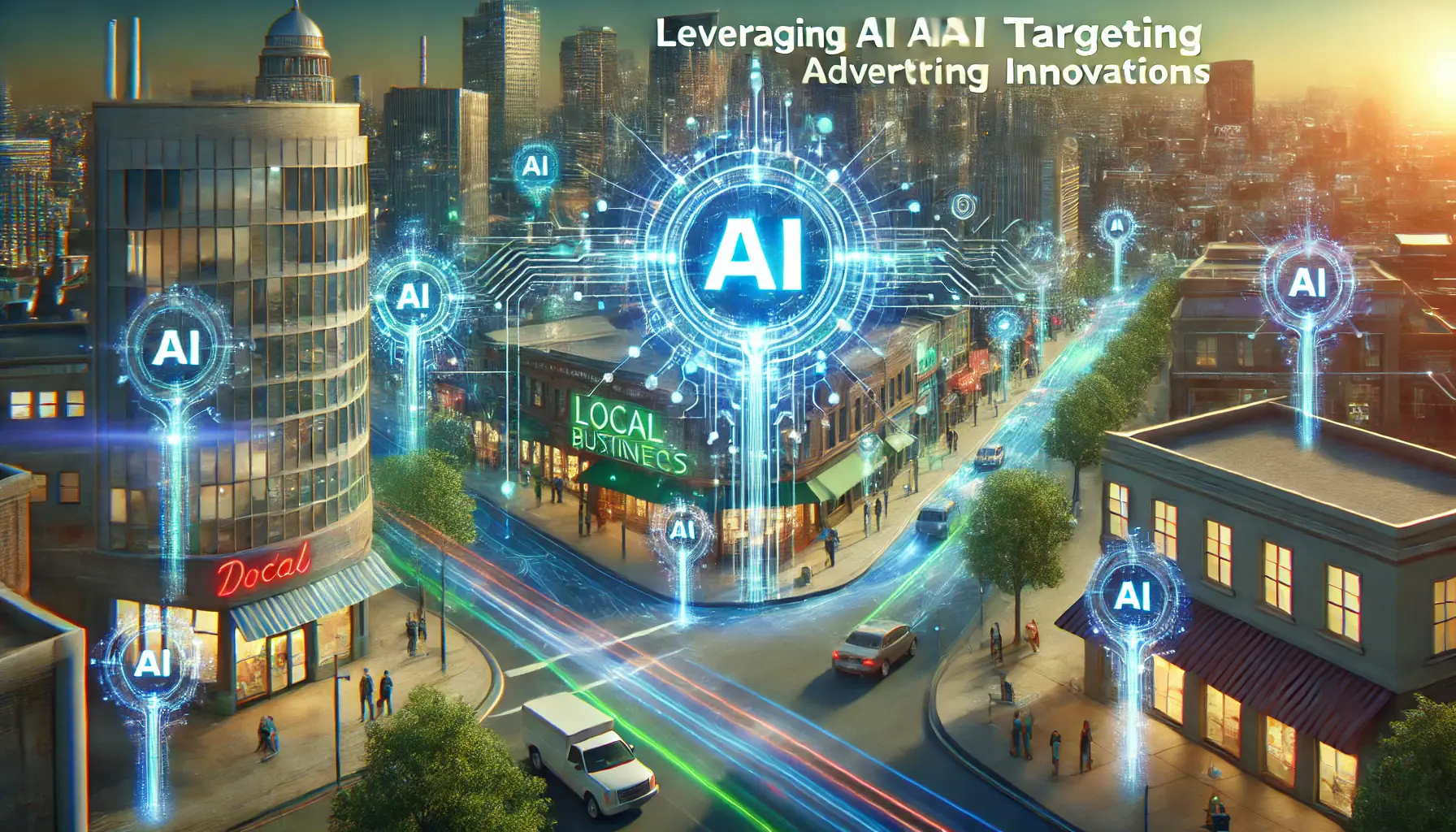In the ever-evolving world of digital advertising, capturing your audience’s attention has never been so important.
Visual engagement plays a central role in creating ads that resonate with viewers and push them to interact and take action.
Whether you run Google Ads for your company or a client, incorporating the right visuals can lead to massive performance boosts in your campaign.
But what exactly makes visuals so impactful, and how can you use them to your advantage?
This article will explore actionable techniques to help you harness the power of visual engagement effectively.
- Understanding the Importance of Visual Engagement in Google Ads
- Implementing Image Extensions to Boost Ad Visibility
- Leveraging Video Content for Enhanced User Engagement
- Optimizing Visuals for Mobile Users in Google Ads
- Utilizing Data-Driven Insights to Enhance Visual Engagement in Google Ads
- Mastering Visual Engagement in Google Ads: A Comprehensive Recap
- FAQs about Visual Engagement in Google Ads
Understanding the Importance of Visual Engagement in Google Ads
Visual engagement is more than just adding eye-catching images or videos to your ads; it’s about using visuals strategically to communicate, evoke emotions, and drive user actions.
In a noisy digital landscape where scores of ads vie for attention, standing out visually is your gateway to success.
To start, consider how visuals impact user behavior.
When viewers encounter an ad, their attention is captured within the first few seconds.
A visually engaging ad ensures that this brief window is used effectively, making a lasting impression.
But how does this translate into measurable results?
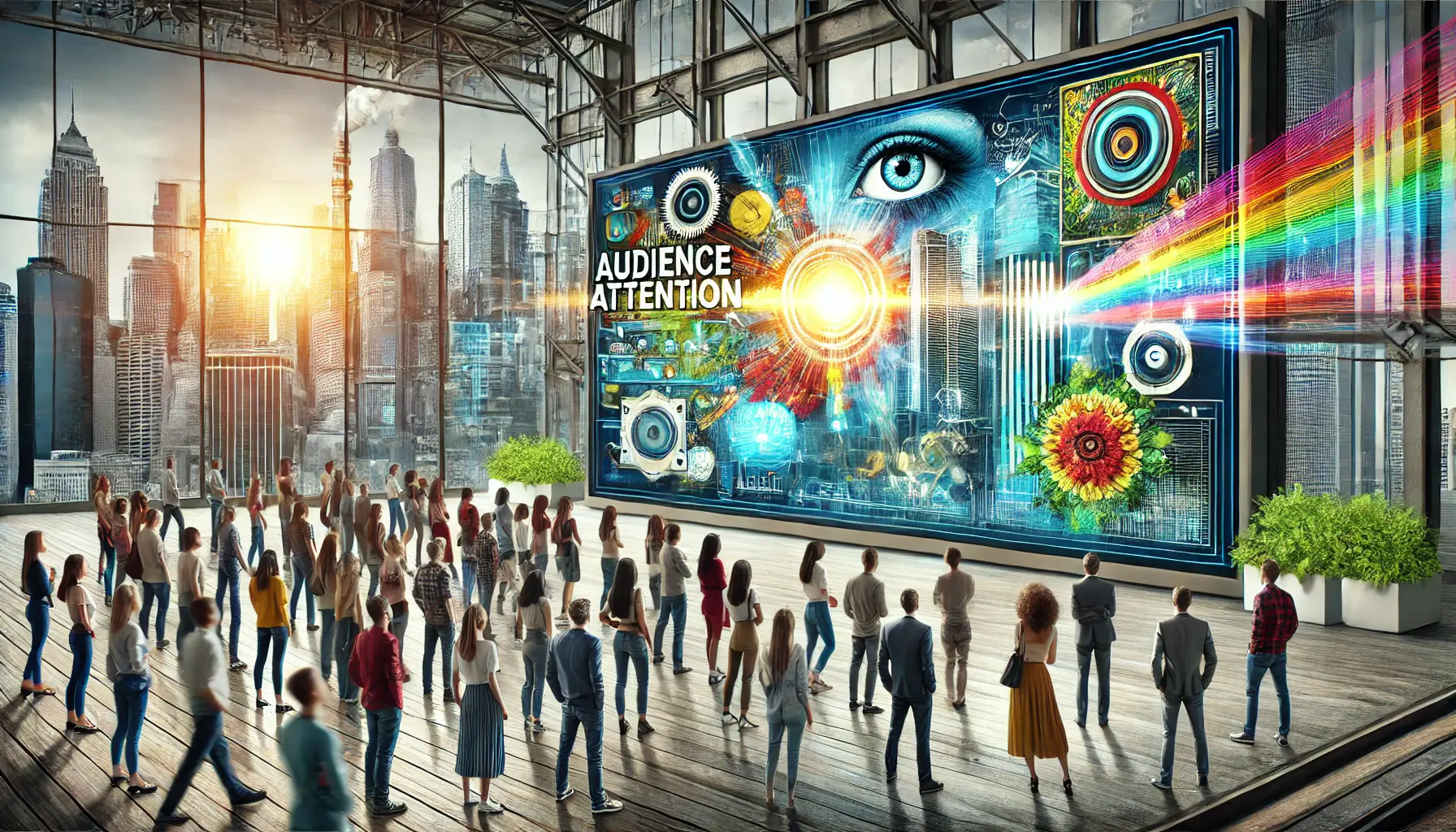
A vibrant depiction of how visuals capture and hold audience attention in modern advertising.
The Role of Visuals in Capturing Audience Attention
Did you know that 90% of the information transmitted to the brain is visual?
This highlights why you need to incorporate strong and relevant visuals in your Google Ads campaigns.
Rich colors, high-quality images, and creative designs can instantly gain the attention of your target audience and encourage them to stay engaged with your ad.
- Emotion: Visuals evoke emotions faster than text, helping you connect with your audience on a deeper level.
- Memorability: People remember visuals more effectively than text, increasing the chances of your ad staying top of mind.
- Clarity: Visuals help simplify complex messages, ensuring your audience understands your offer quickly.

A depiction of how visual engagement influences click-through rates in advertising campaigns.
Impact of Visual Engagement on Click-Through Rates
Visual engagement directly influences click-through rates (CTRClick-Through Rate, a metric that measures the number of clicks an ad receives divided by the number of impressions.).
Ads with compelling visuals often see higher CTRs because they stand out in search results or display networks.
Consider the following tips to maximize your CTR:
- Use relevant visuals that align with your target audience’s preferences and expectations.
- Ensure your visuals complement the ad copy, reinforcing your message.
- Experiment with different visual elements like animations, infographics, and carousel ads.

A creative scene illustrating the use of cohesive visuals to strengthen brand recall.
Enhancing Brand Recall Through Effective Visuals
Beyond driving clicks, visual engagement significantly enhances brand recallThe ability of consumers to remember a brand based on its visual or auditory elements..
When users repeatedly see visually consistent and appealing ads, they are more likely to remember your brand and trust your offerings.
Incorporating elements like your logo, brand colors, and signature styles helps establish a strong brand identity.
With visual engagement forming the backbone of successful Google Ads, the next sections will dive deeper into specific strategies to implement these principles.
Stay tuned as we explore the power of image extensions, video content, and data-driven insights to supercharge your campaigns.
Visual engagement is not just about aesthetics but strategically leveraging visuals to communicate, evoke emotions, and drive user actions effectively.
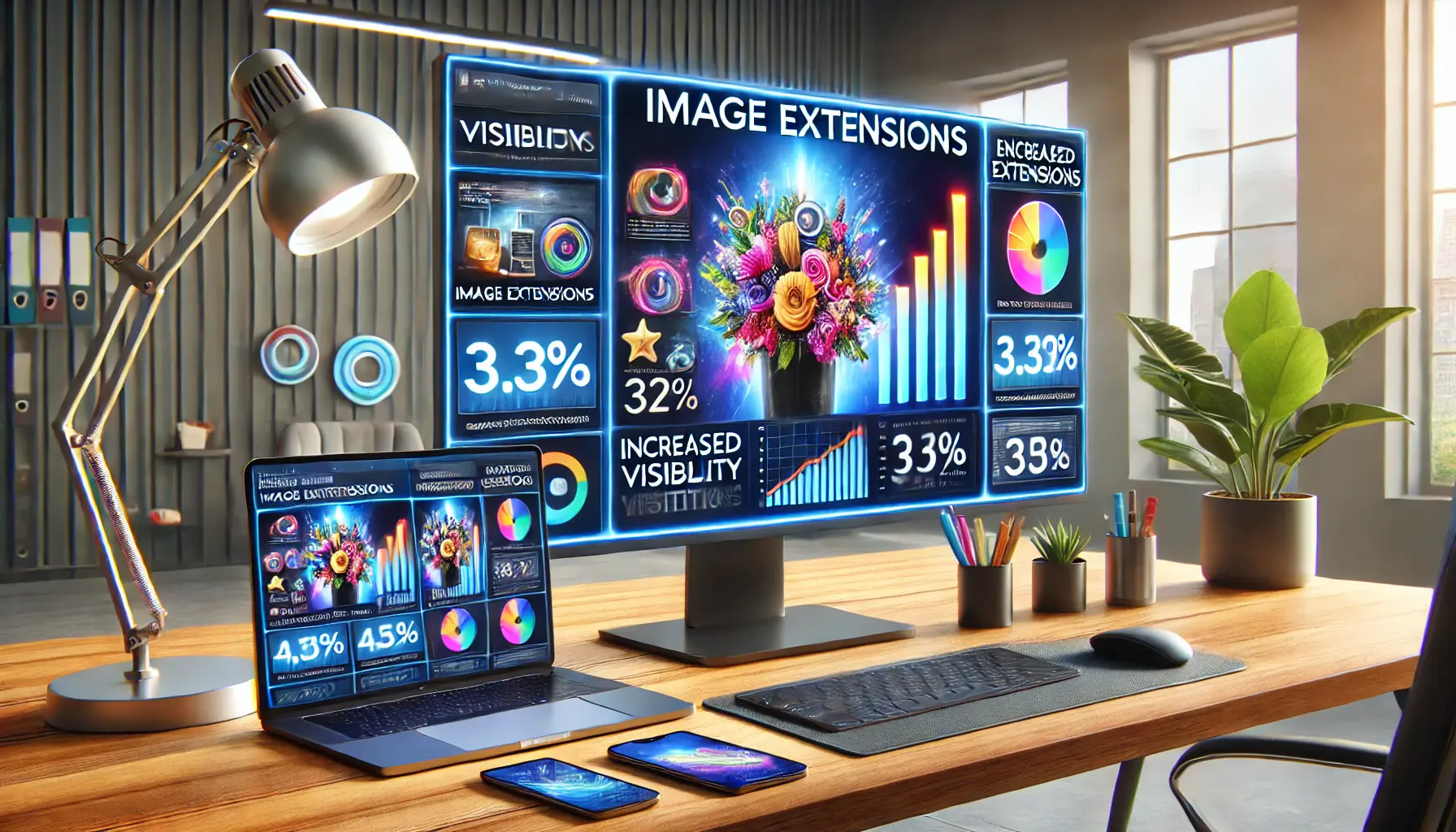
undefined
Implementing Image Extensions to Boost Ad Visibility
Enhancing your Google Ads with image extensions can significantly increase visual engagement, making your ads more appealing and informative.
By incorporating relevant visuals, you can capture your audience’s attention more effectively and convey your message succinctly.

A scene highlighting the effectiveness of image extensions in enhancing ad performance and engagement.
Benefits of Using Image Extensions in Google Ads
Image extensions allow you to complement your text ads with rich, relevant visuals, providing several advantages:
- Increased Click-Through Rates (CTR): Ads featuring compelling images often experience higher CTRs, as they stand out more prominently in search results.
- Enhanced User Experience: Visuals can convey complex information quickly, aiding users in understanding your offerings at a glance.
- Improved Brand Recall: Consistent and appealing imagery helps reinforce brand identity, making your brand more memorable to potential customers.
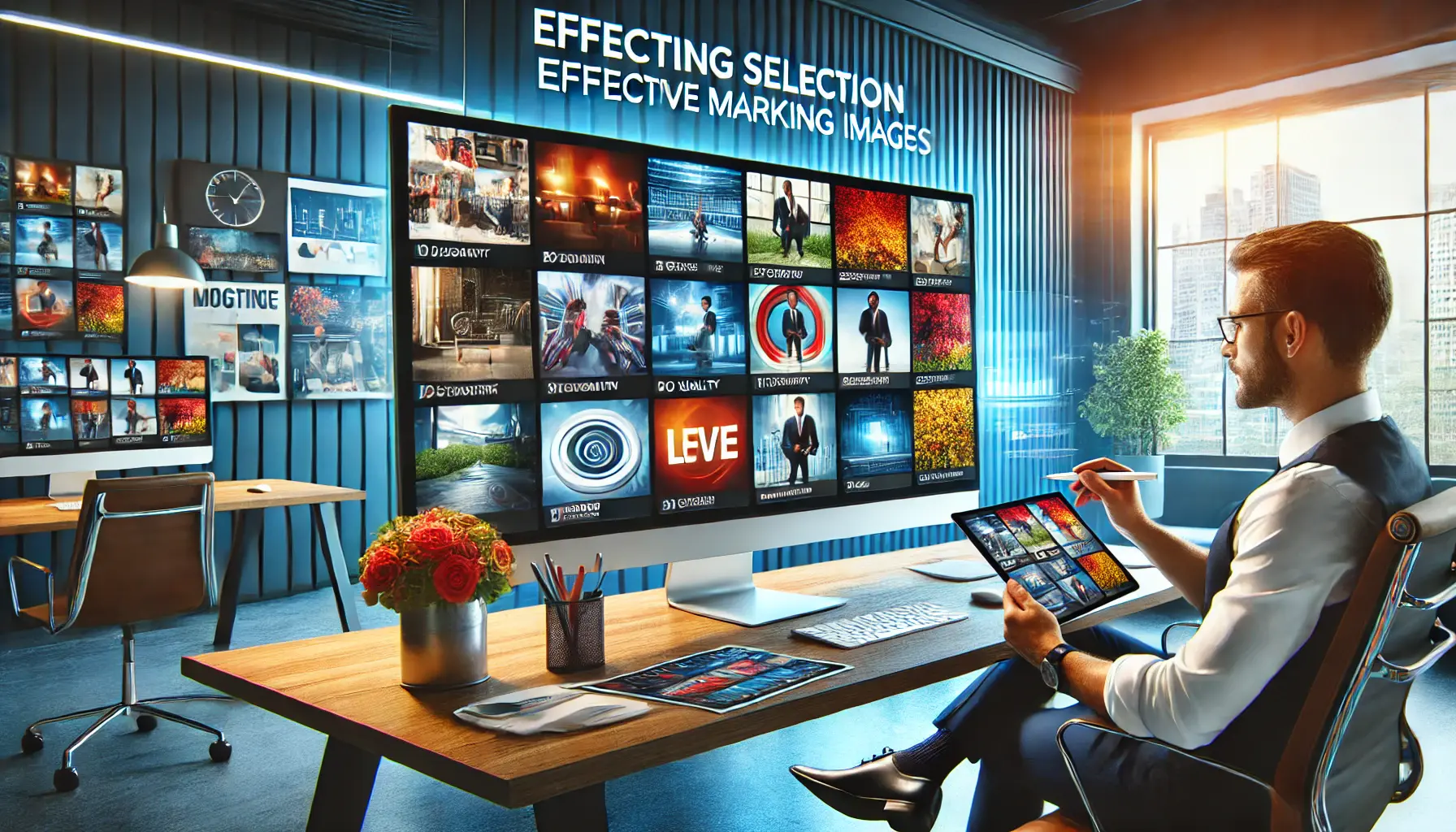
A visual representation of the strategic process for selecting effective marketing images.
Best Practices for Selecting Effective Images
The following are some best practices to ensure that image extensions create maximum impact:
- Relevance: Use images closely related to your ad copy and keywords to maintain consistency and relevance.
- Quality: Use high-resolution images that are clear and professional-looking to showcase the quality of your brand.
- Compliance: Ensure that your images follow Google’s guidelines regarding no text overlays, excessive whitespace, or inappropriate content.
- Variety: Upload multiple images with different themes, such as product shots and lifestyle imagery, to appeal to a broader audience.
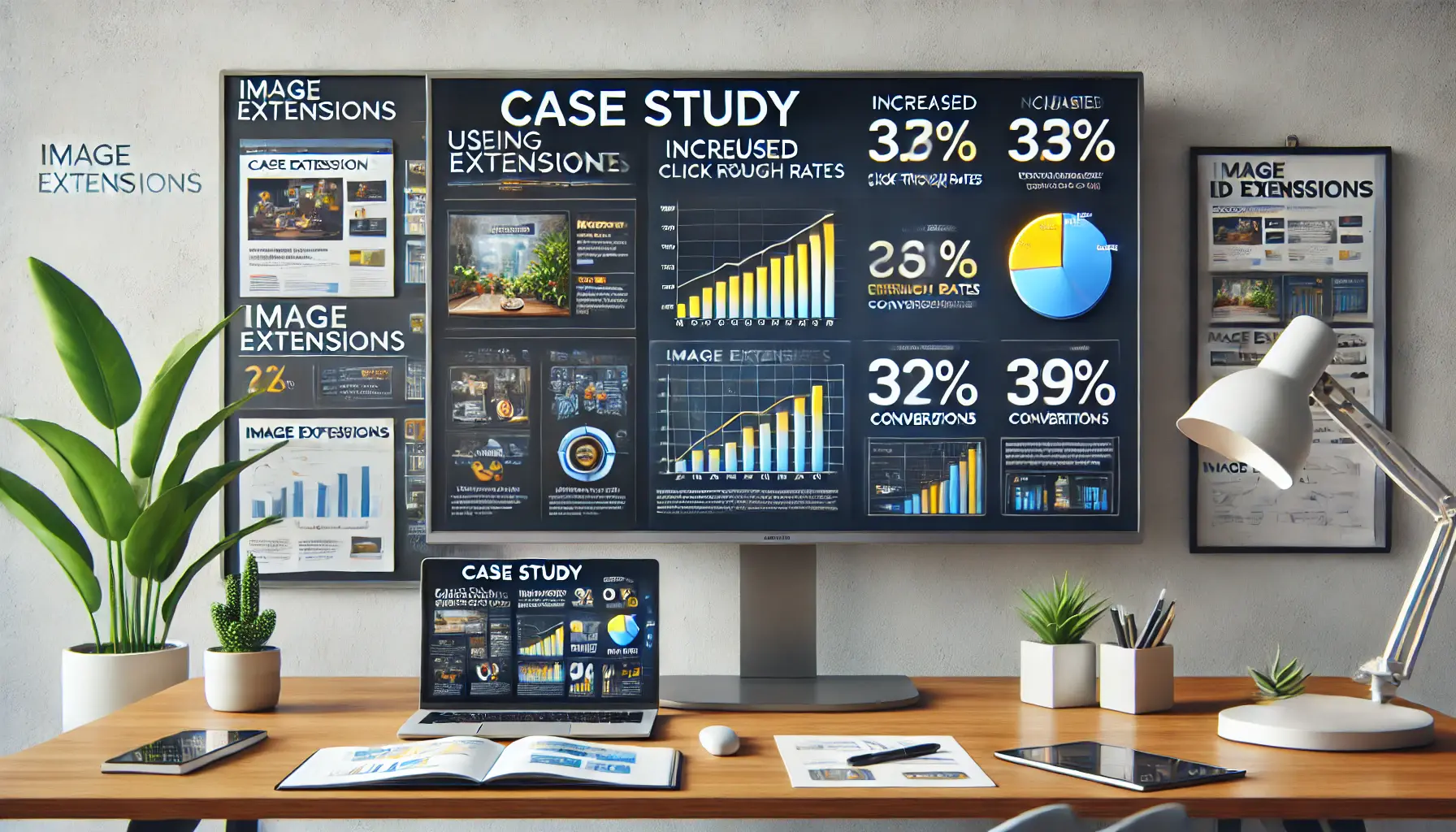
A visual representation of success stories highlighting the impact of image extensions in digital advertising.
Case Studies: Success Stories with Image Extensions
Examining real-life examples can provide valuable insights into the effectiveness of image extensions:
- London Encaustic: This premium artisanal tile and bath retailer saw a 35% increase in CTR after implementing image extensions, rising from 6.37% to 12.5%.
- Bison Security Posts: For this company, image extensions appeared in 30% of mobile impressions but accounted for 50% of all clicks, highlighting their impact on user engagement.
By thoughtfully integrating image extensions into your Google Ads strategy, you can enhance visual engagement, improve ad performance, and achieve better overall campaign results.
Using image extensions is a proven method to increase ad visibility and make complex messages more digestible.
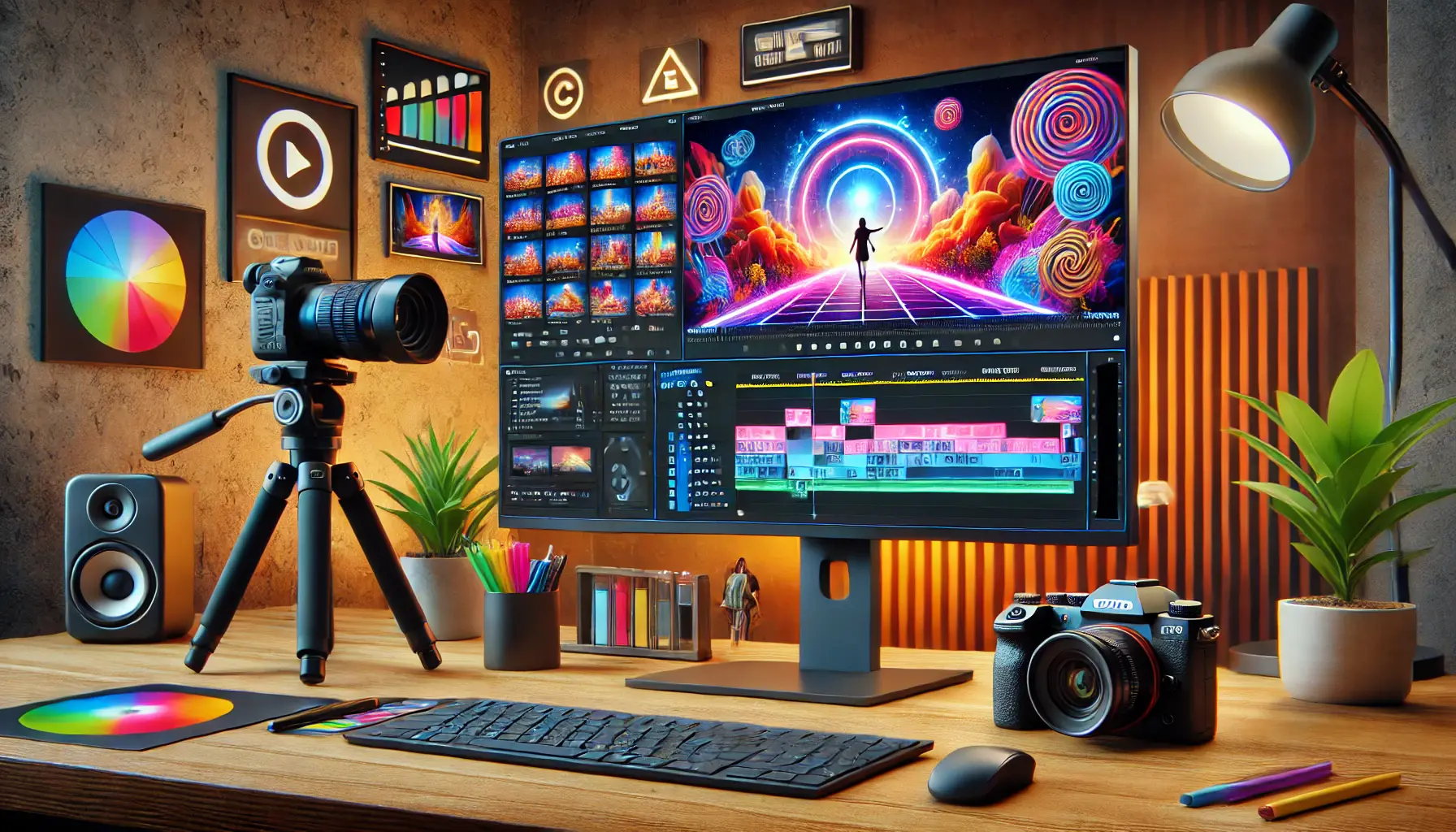
A creative representation of video content’s role in boosting user engagement in digital campaigns.
Leveraging Video Content for Enhanced User Engagement
Incorporating video content into your Google Ads strategy can significantly boost visual engagement, capturing your audience’s attention and conveying your message more effectively.
Videos offer a dynamic way to showcase your products or services, making them more appealing to potential customers.
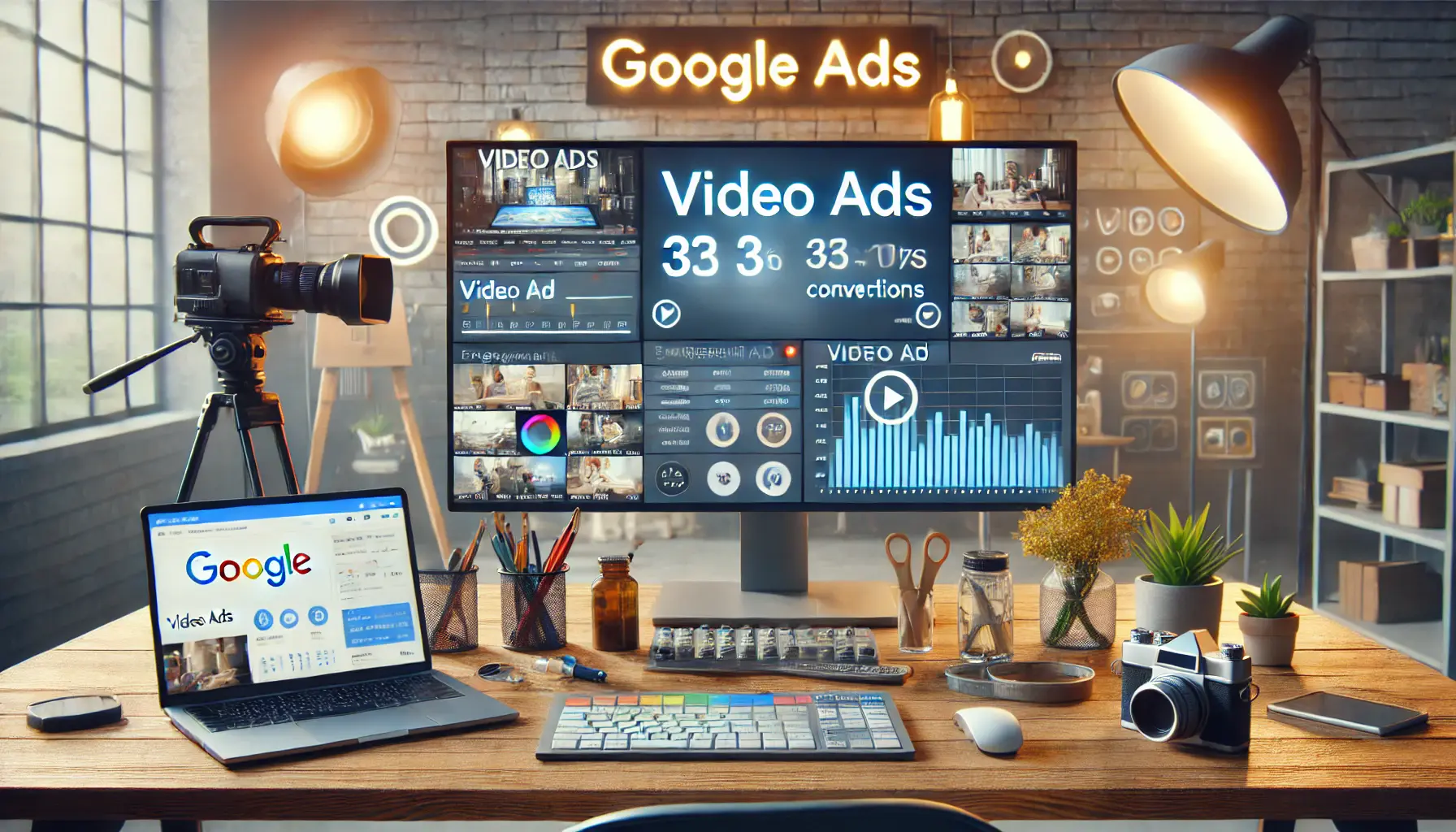
A visual representation of the effectiveness of video ads in Google Advertising campaigns.
Advantages of Video Ads in Google Advertising
Utilizing video ads within Google Advertising provides several benefits:
- Higher Engagement: Videos can more effectively capture the attention of users, leading to increased interaction and longer time spent on your ads.
- Improved Brand Recall: Engaging video content helps reinforce brand identity, making your brand more memorable to potential customers.
- Better Conversion Rates: Videos can convey complex information quickly, aiding users in understanding your offerings at a glance, which can lead to higher conversion rates.
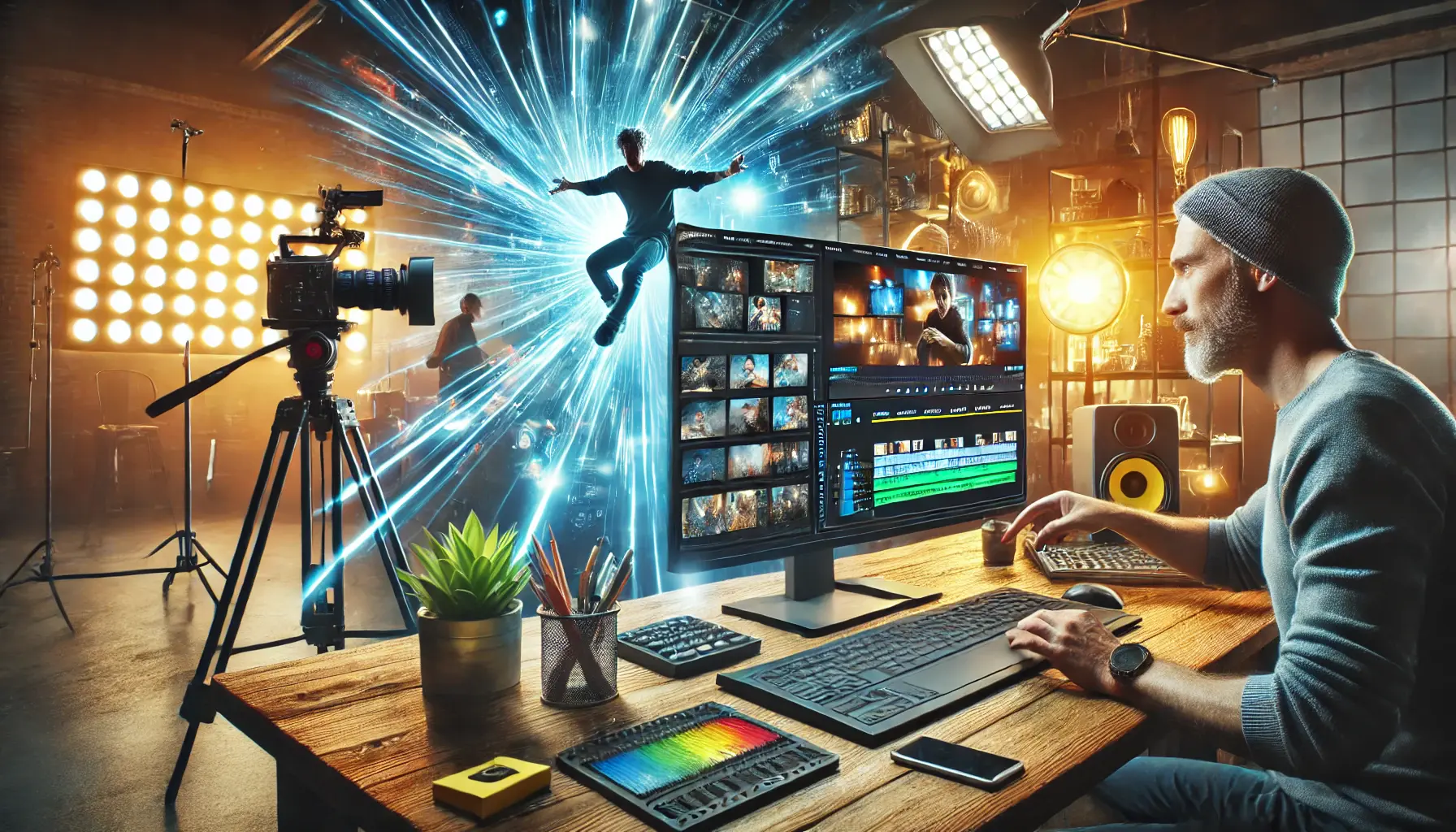
undefined
Creating Compelling Video Content for Your Audience
To maximize the impact of your video ads, consider the following best practices:
- Understand Your Audience: Tailor your video content to align with your target audience’s preferences and expectations.
- Keep It Concise: Ensure your video delivers the message succinctly, as shorter videos tend to retain viewer attention better.
- Include a Clear Call-to-Action (CTA): Direct viewers on what to do next, whether it’s to visit your website, make a purchase, or sign up for a newsletter.
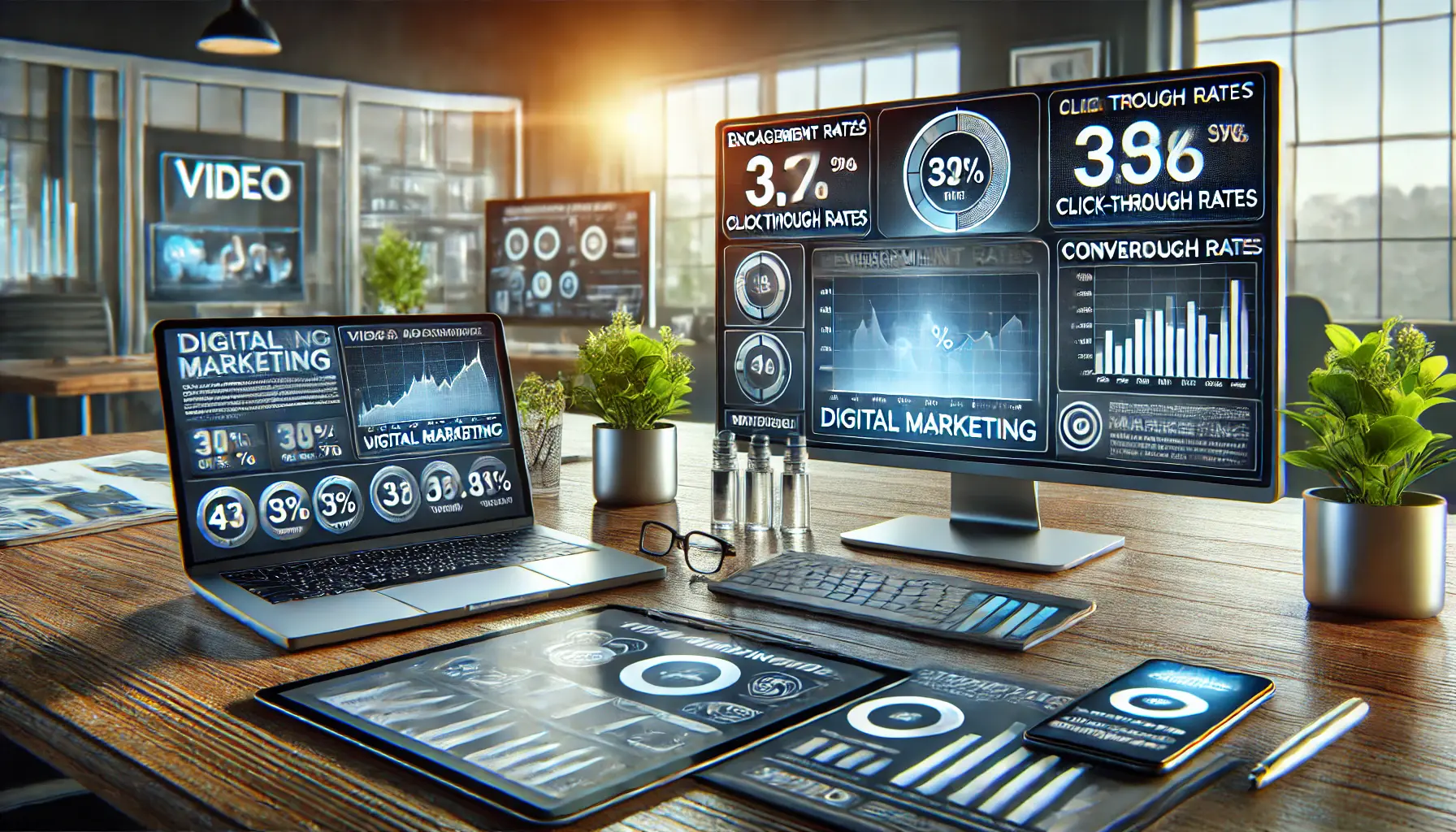
A professional workspace emphasizing the role of data in measuring the success of video ad campaigns.
Measuring the Success of Video Ad Campaigns
Assessing the effectiveness of your video ads is critical to refining your approach.
Key metrics to track include:
- View Rate: The number of people who viewed your video ad out of the total impressions delivered to viewers.
- CTR (Click-Through Rate): The number of clicks divided by the impressions, which shows how well your ad is prompting people to take action.
- Conversion Rate: The number of viewers who completed a desired action after watching your video, expressed as a percentage.
By analyzing these metrics, you can gain insights into your video’s effectiveness and make data-driven decisions to enhance future campaigns.
Videos captivate attention more effectively than static visuals, driving higher engagement and conversions.

A modern workspace illustrating the importance of optimizing visuals for mobile users in Google Ads.
Optimizing Visuals for Mobile Users in Google Ads
In today’s mobile-centric world, ensuring that your Google Ads are optimized for mobile users is crucial for maximizing visual engagement.
Mobile devices account for a significant portion of online traffic, making it essential to tailor your ad visuals to provide a seamless and compelling experience for users on the go.

A visual representation of the importance of mobile-optimized visuals for ads across devices.
Importance of Mobile-Optimized Visuals
Mobile users tend to be more distracted and less likely to engage with anything other than ads that are easy to understand upon first glance.
Optimizing your visuals for mobile devices can result in the following:
- Improved User Experience: Clear and concise visuals increase user satisfaction, reduce bounce rates, and enhance the likelihood of conversions.
- Higher Engagement Rates: Mobile-optimized visuals are more likely to capture attention, leading to increased interaction with your ads.
- Better Ad Performance: Ads tailored for mobile devices often achieve higher click-through rates (CTR) and return on investment (ROI).

A visual depiction of best practices for optimizing mobile visuals in digital advertising.
Best Practices for Mobile Visual Optimization
To effectively optimize your ad visuals for mobile users, consider the following strategies:
- Responsive Design: Ensure your ad creative adapts seamlessly to different screen sizes and orientations for a consistent user experience across devices.
- Prioritize Readability: Use readable fonts and font sizes to ensure text is easily visible on small screens.
- Optimize Image Sizes: Compress images to reduce load times without sacrificing quality, improving the user experience.
- Clear Call-to-Action (CTA): Place prominent and easily tappable CTAs to guide users toward the desired action.
- Avoid Clutter: Keep visuals simple and focused, avoiding excessive text or complex images that may overwhelm mobile users.

A professional scene highlighting mobile-friendly ad formats, showcasing responsive design and mobile optimization.
Utilizing Mobile-Friendly Ad Formats
Google Ads offers several ad formats optimized for mobile devices:
- Responsive Display Ads: These ads automatically adjust their size, appearance, and format to fit available ad spaces, ensuring optimal display across devices.
- Call-Only Ads: Specifically designed for mobile users, these ads encourage direct calls to your business, streamlining the conversion process.
- App Promotion Ads: Ideal for driving app downloads, these ads are tailored to appear on mobile devices, targeting users more likely to install your app.
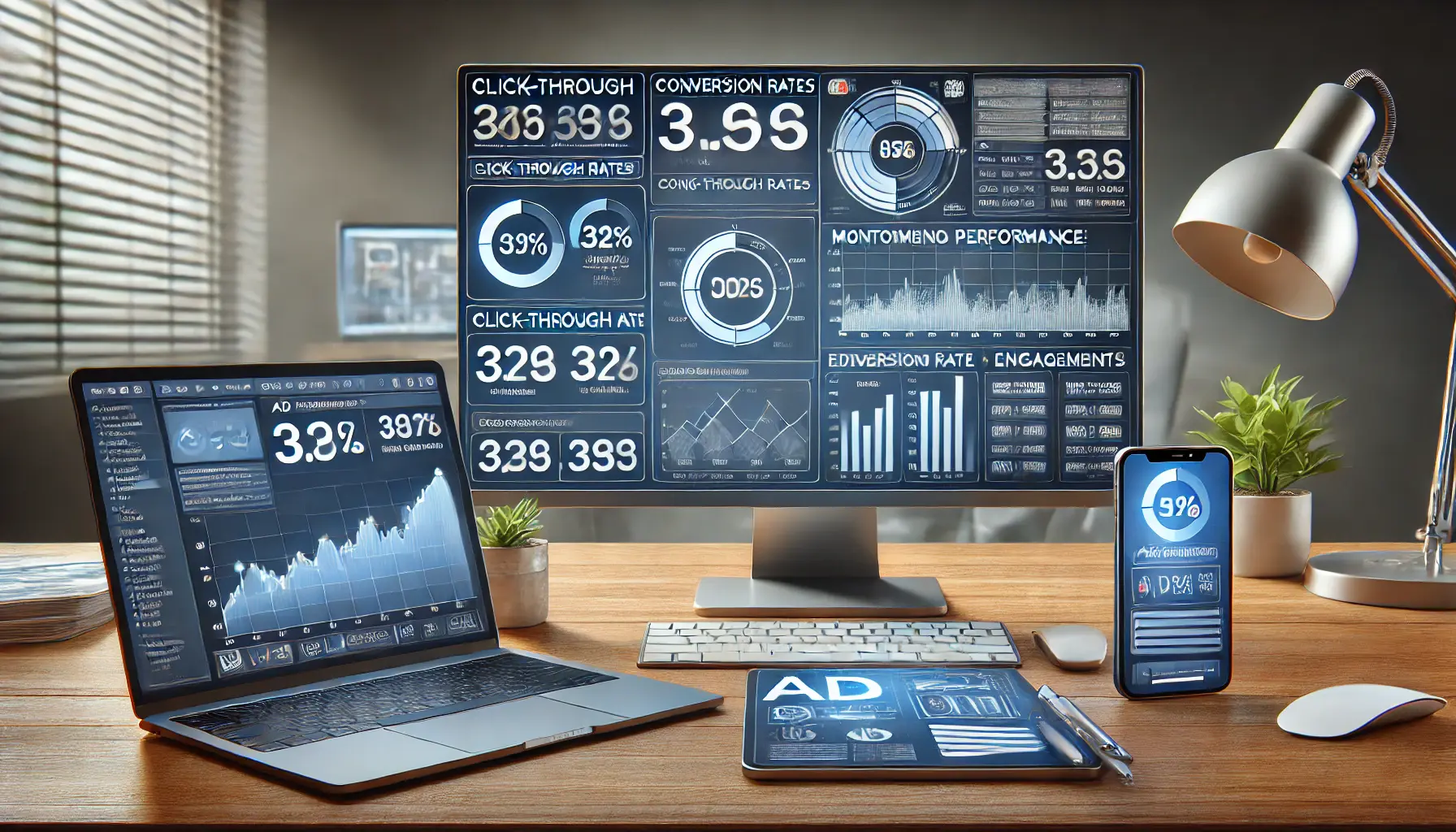
A professional workspace illustrating the process of monitoring and adjusting ad performance for optimal results.
Monitoring and Adjusting for Optimal Performance
Frequently analyze the performance of your mobile ads to identify areas for improvement.
Use Google Ads analytics tools to monitor key metrics such as CTR, conversion rate, and user engagement.
With these insights in hand, make data-driven adjustments to your visuals and overall ad strategy to continuously enhance performance.
By focusing on mobile optimization, you can drastically improve visual engagement, deliver a better user experience, and achieve greater success with your Google Ads campaigns.
- Ensure visuals are mobile-optimized to provide a seamless user experience.
- Responsive designs and concise CTAs are critical for engaging mobile users.
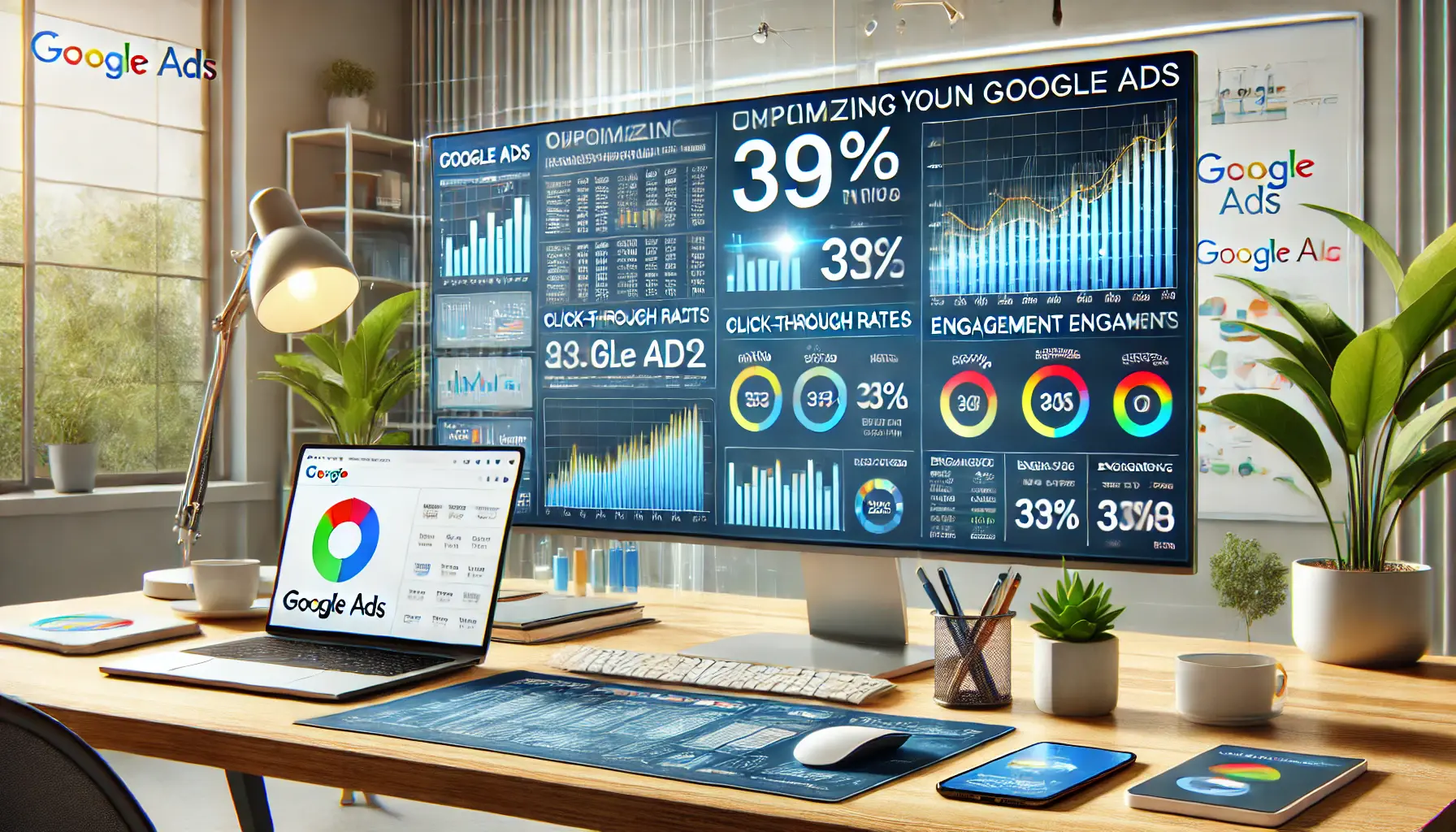
A professional workspace highlighting the use of data-driven insights to optimize visual engagement in Google Ads.
Utilizing Data-Driven Insights to Enhance Visual Engagement in Google Ads
Incorporating data-driven insights into your Google Ads strategy is essential for optimizing visual engagement.
By analyzing user behavior and ad performance, you can make informed decisions that enhance the effectiveness of your visual content.
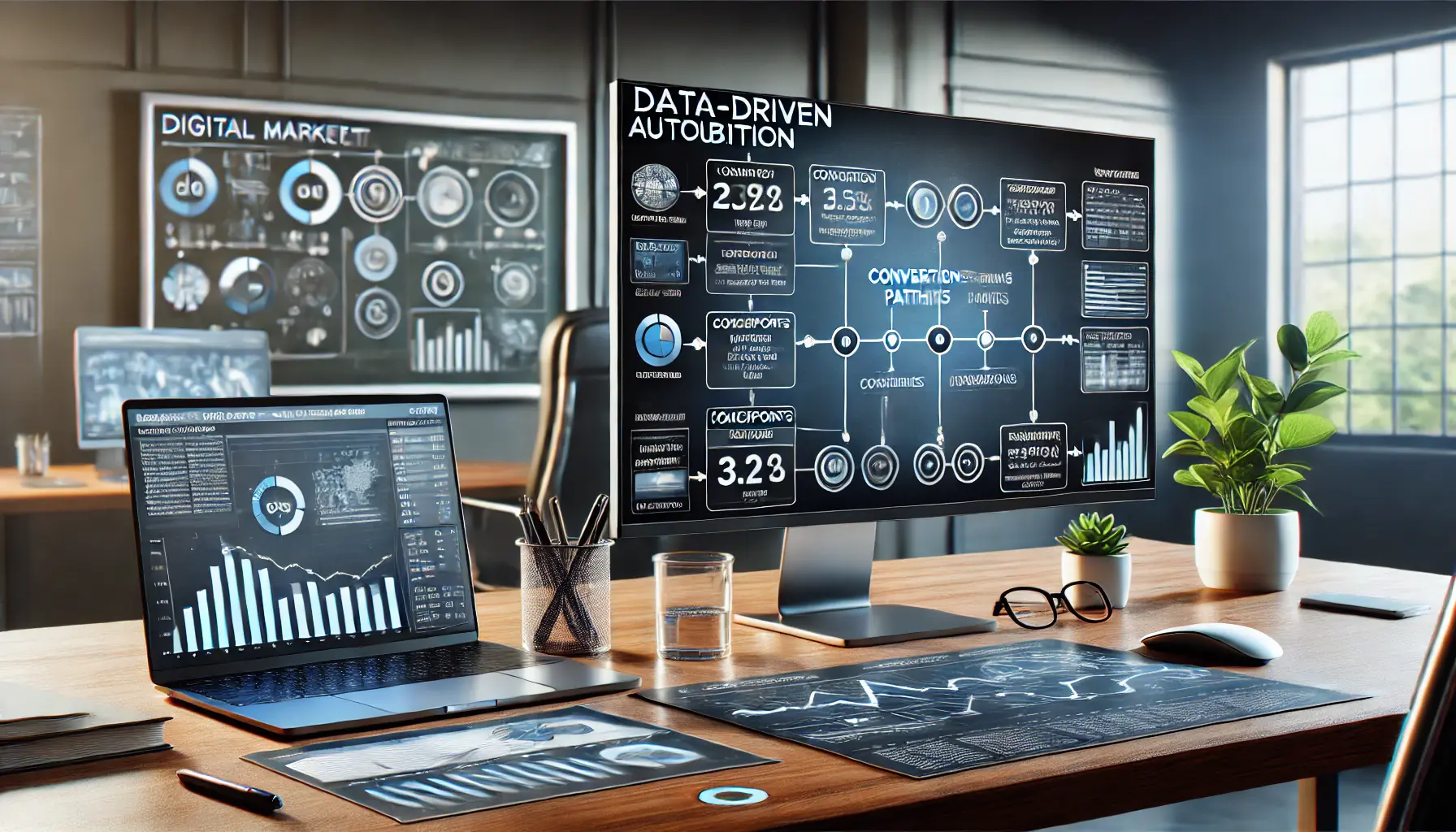
undefined
Understanding Data-Driven Attribution
Data-driven attribution assigns credit to various touchpoints in the customer journey based on their actual contribution to conversions.
Unlike traditional models, it utilizes machine learning to analyze all relevant data, providing a more accurate assessment of each interaction’s impact.
Implementing data-driven attributionA model that uses data and machine learning to assign credit to different touchpoints in the customer journey. can lead to better-informed decisions regarding visual content placement and design.

A professional workspace illustrating the use of Google Analytics for optimizing visuals in digital marketing.
Leveraging Google Analytics for Visual Optimization
Google Analytics offers valuable insights into how users interact with your ads.
By examining metrics such as session duration, pages per session, and engagement rates, you can identify which visuals resonate with your audience.
Integrating Google Analytics with your Google Ads account enables you to track the performance of visual elements and adjust your strategy accordingly.
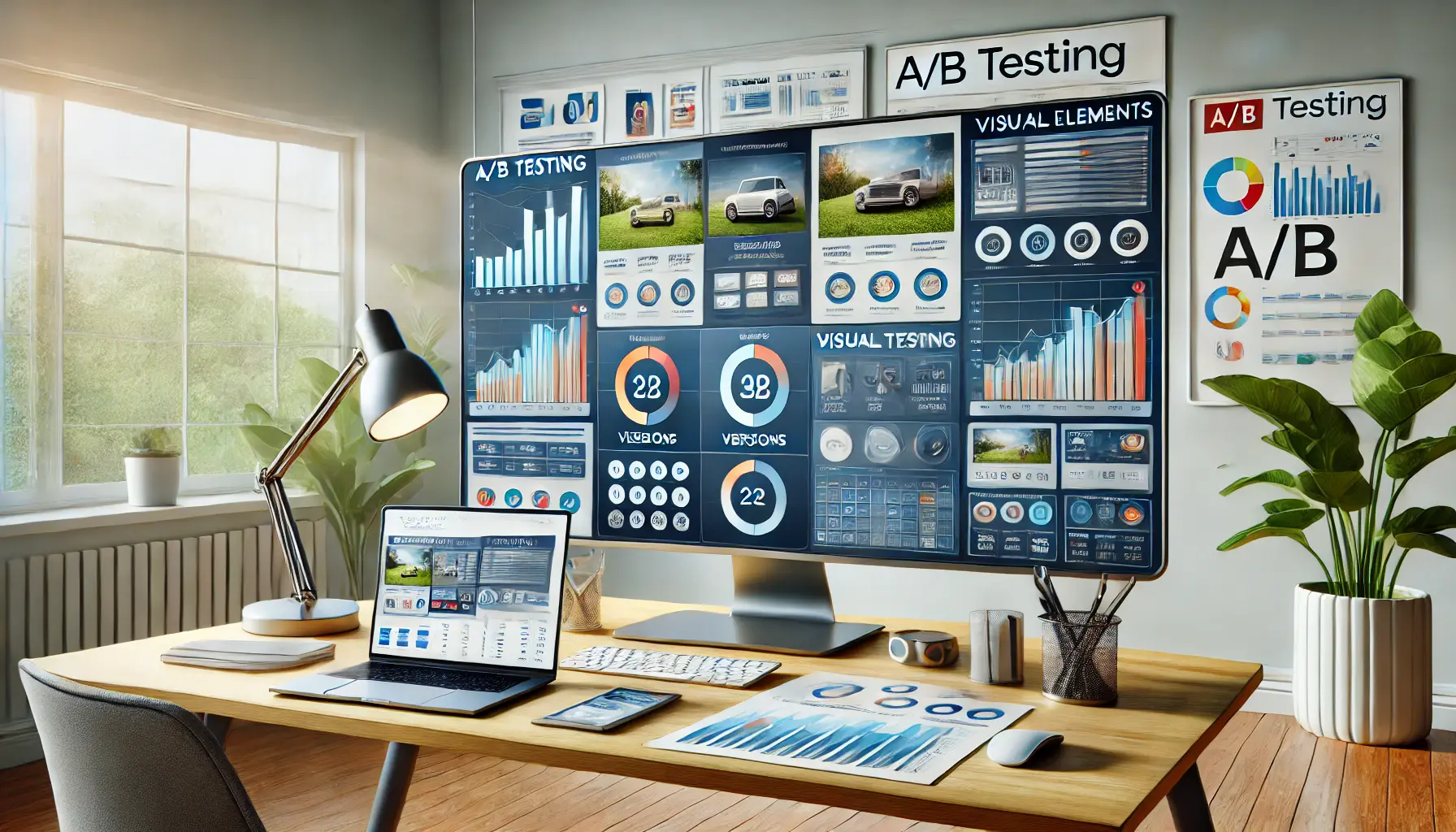
A professional workspace illustrating the process of A/B testing for optimizing visual elements in ads.
Implementing A/B Testing for Visual Elements
A/B testing involves creating multiple versions of an ad with varying visual components to determine which performs better.
By systematically testing different images, colors, and layouts, you can identify the most effective visuals for engaging your target audience.
Continuous A/B testingA method of comparing two versions of an element, such as an ad, to determine which performs better. allows for ongoing optimization of visual content.

undefined
Utilizing AI-Powered Tools for Creative Analysis
Artificial intelligence can enhance creative analysis by providing deeper insights into ad performance.
Tools like Google Ads Data Manager consolidate first-party data, enabling a complete view of how visuals impact user engagement.
AI-driven analytics can uncover patterns and trends that inform more effective visual strategies.
By integrating data-driven insights into your Google Ads campaigns, you can refine your visual content for better engagement with your audience and improve ad performance and conversion rates.
A/B testing and AI-powered analytics help refine visual strategies for maximum user engagement.
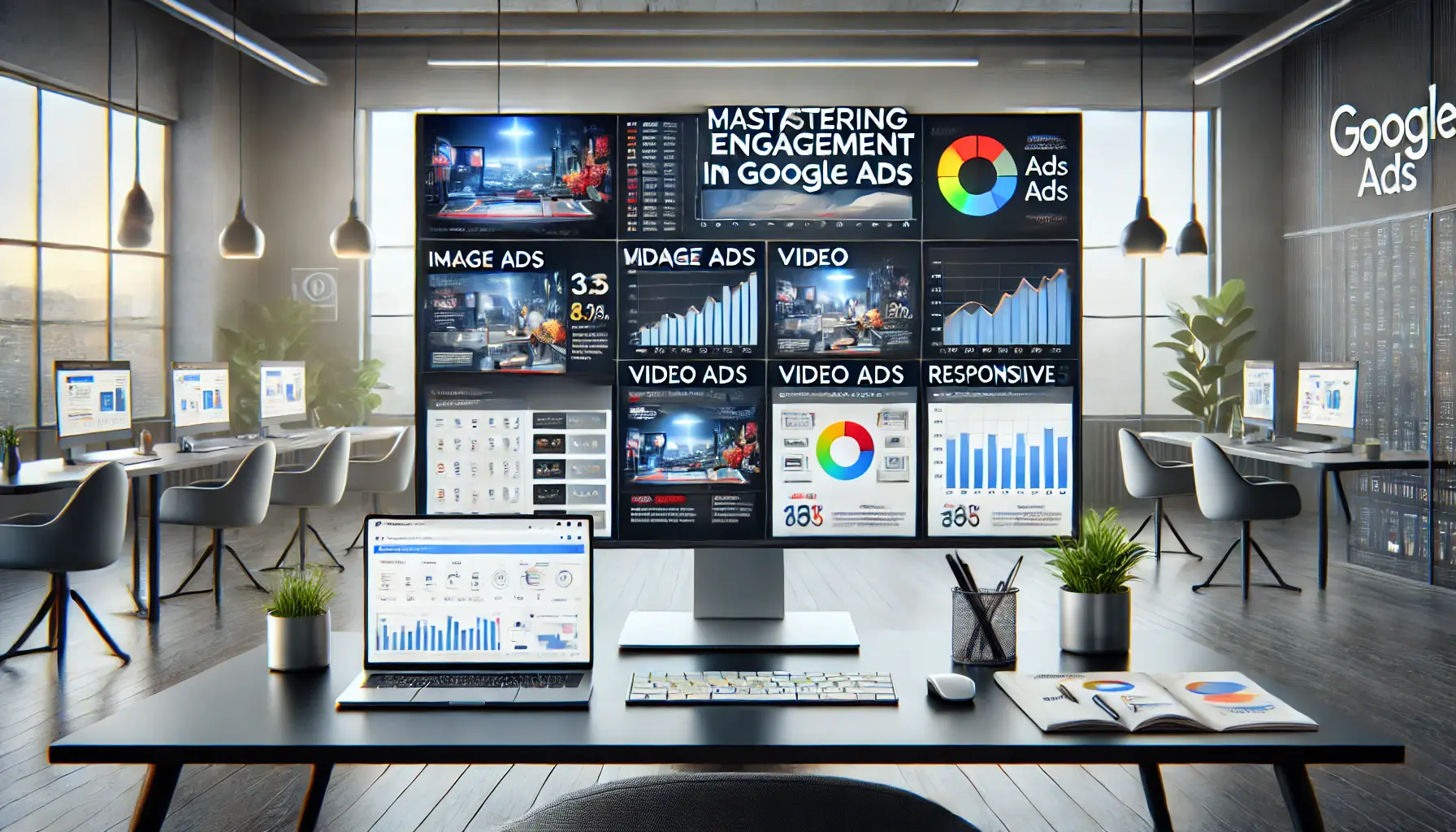
A visual recap of mastering visual engagement in Google Ads, highlighting various ad types and their performance metrics.
Mastering Visual Engagement in Google Ads: A Comprehensive Recap
As digital advertising continues to evolve, mastering visual engagement has become an essential component for creating impactful Google Ads campaigns.
By leveraging visuals effectively, businesses can capture attention, improve user experience, and drive conversions.
This article explored actionable strategies for achieving outstanding results with visually engaging ads.

A visual summary of key takeaways on visual engagement in digital advertising.
Key Takeaways on Visual Engagement
From understanding the power of visuals to optimizing them for various platforms, here are the core takeaways from this article:
- Importance of Visual Engagement: Visuals help gain attention, build brand recall, and drive CTR.
- Image Extensions: Image extensions work effectively as long as the images are relevant and of high quality; this increases ad visibility and user interaction.
- Video Content: Video ads offer dynamic ways to engage audiences, delivering messages effectively and boosting conversion rates.
- Mobile Optimization: Ensuring visuals are mobile-friendly enhances the user experience and increases ad performance on smaller screens.
- Data-Driven Insights: Utilizing analytics tools and A/B testing enables advertisers to refine their visual strategies for maximum impact.
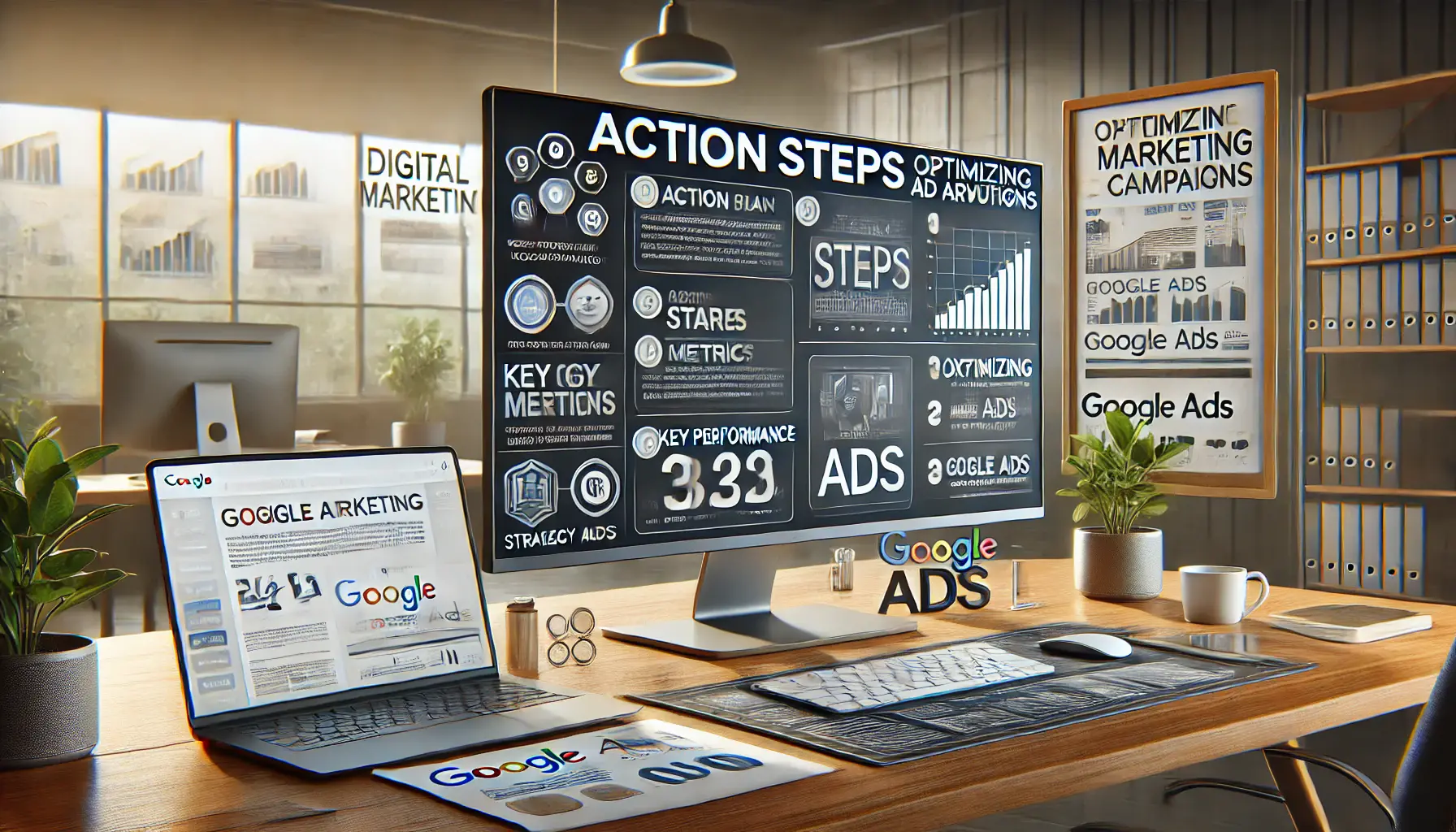
A visual representation of action steps for advertisers to optimize their ad campaigns.
Action Steps for Advertisers
To excel in visual engagement with Google Ads, consider these actionable steps:
- Regularly analyze your audience’s preferences to create visuals that resonate.
- Incorporate image and video extensions to diversify your ad formats.
- Optimize visuals for mobile devices by focusing on responsiveness and simplicity.
- Leverage data-driven insights to continuously improve ad performance through testing and analysis.
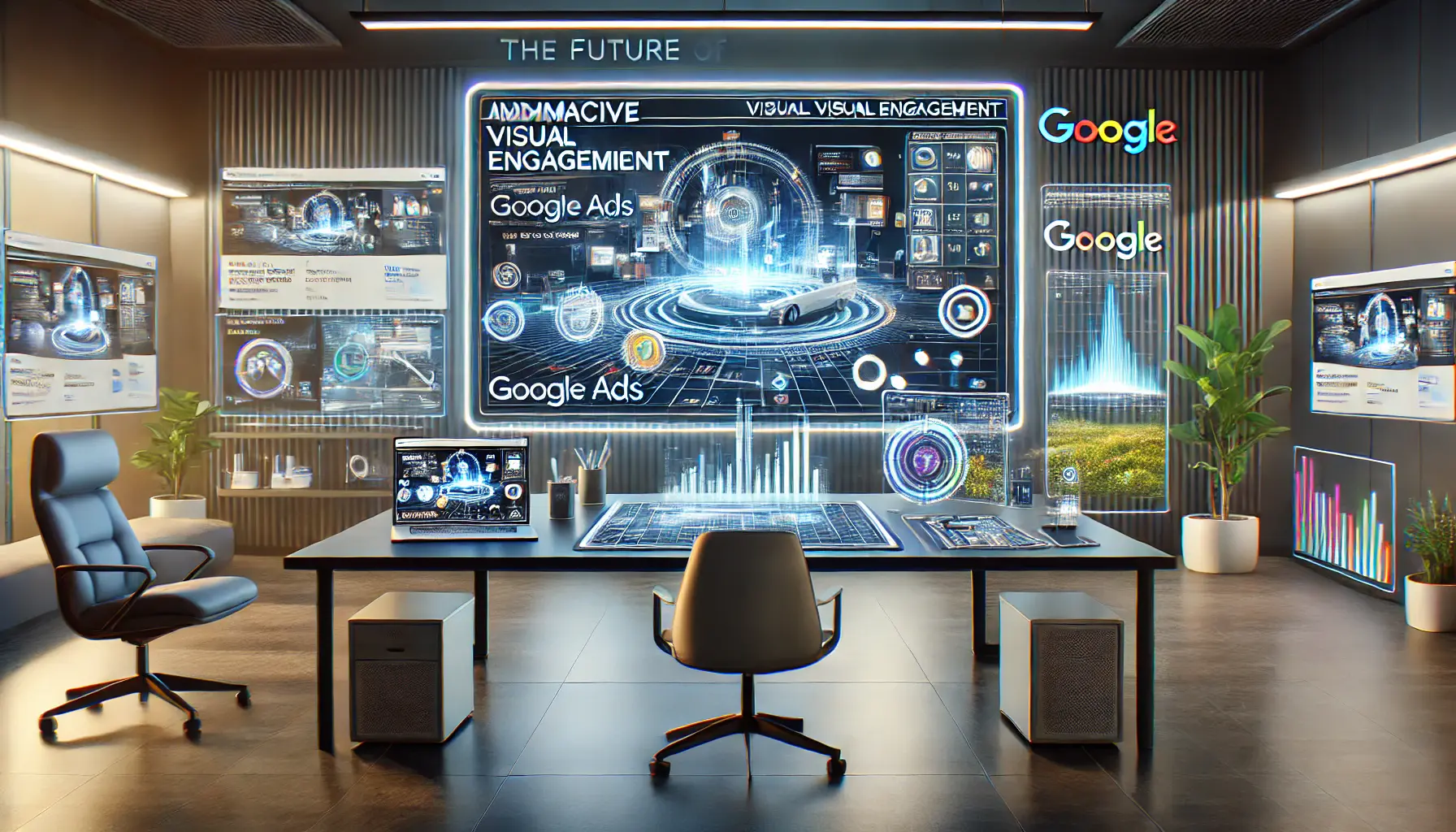
A futuristic workspace illustrating the next generation of visual engagement in Google Ads.
Future of Visual Engagement in Google Ads
The digital advertising landscape is ever in flux, and one must be prepared to adapt and innovate to stay ahead.
As AI and machine learning continue to evolve, they will play an even greater role in shaping visual engagement strategies.
Advertisers must move with the tide if they want to remain competitive and create compelling campaigns that drive results.
By focusing on the principles and strategies in this article, you will not only elevate your Google Ads campaigns but also achieve lasting success through the power of visual engagement.
By mastering visual engagement, you ensure your Google Ads campaigns capture attention, enhance brand recall, and drive measurable results.
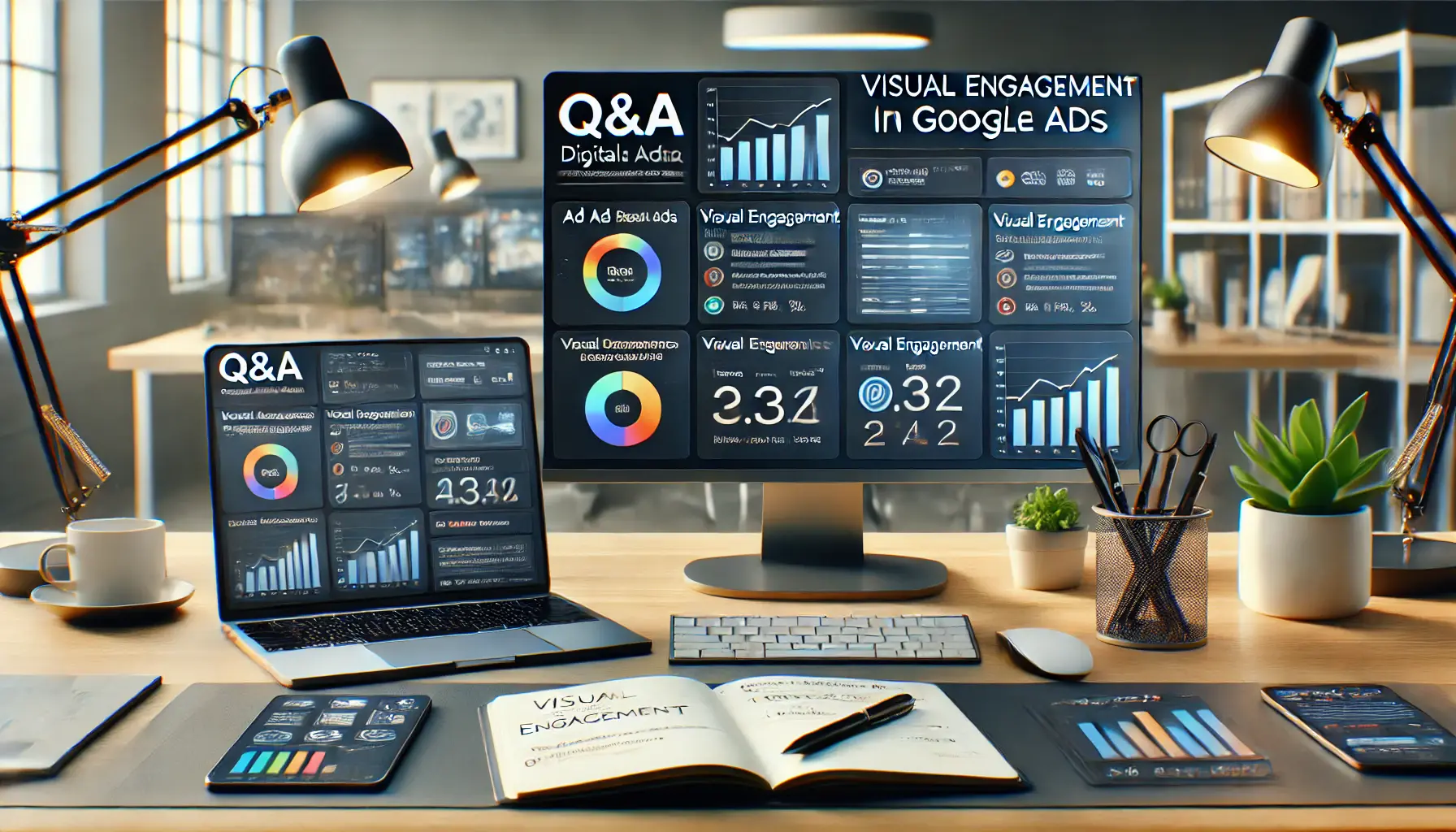
A professional workspace designed for answering questions related to visual engagement in Google Ads.
Your campaigns can be managed by an agency specialized in Google Ads, check out our service page.
FAQs about Visual Engagement in Google Ads
Developing visual engagement in a Google Ad helps to connect audiences and drive conversions.
See below for commonly asked questions and quick responses to keep your ad visuals in perfect optimization.
Visual engagement defines how strongly the visual parts of an ad capture the attention of users and hold it while interacting with and responding to the ad.
Image extensions add relevant visuals to text ads, making them more appealing and informative, which can lead to higher click-through rates and improved user engagement.
Choose high-quality, relevant images that align with your ad copy and audience preferences.
Ensure compliance with Google’s image guidelines to maintain ad quality and effectiveness.
Video ads provide dynamic content that can effectively capture user attention, convey messages succinctly, and lead to higher engagement and conversion rates compared to static images.
With a significant portion of users accessing content via mobile devices, optimizing ad visuals for mobile ensures a seamless user experience, leading to better engagement and ad performance.
Analyzing user behavior and ad performance data helps in making informed decisions about visual content, allowing for continuous optimization and improved effectiveness of ads.
A/B testing involves creating multiple versions of an ad with varying visual elements to determine which version performs better, facilitating data-driven optimization of ad content.
Responsive design ensures that ad visuals adapt seamlessly to different screen sizes and orientations, providing a consistent and engaging user experience across all devices.
AI-powered tools analyze vast amounts of data to identify patterns and trends, offering insights that inform more effective visual strategies and enhance ad performance.







